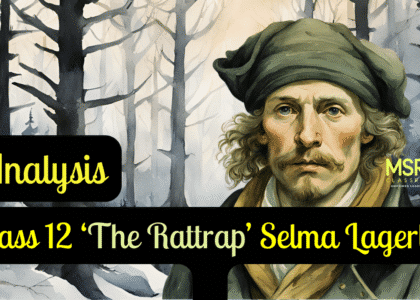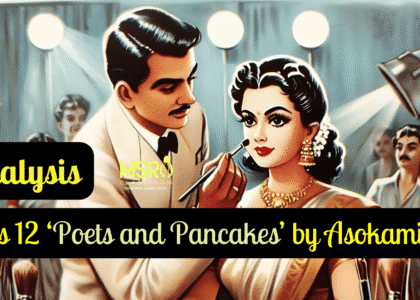Chapter 7, Christopher Silvester’s ‘The Interview’ (Part 1) Summary, Theme, Character Sketches, Metaphorical Expressions, Question Answers.
Chapter 7- The Interview (Part 1) by Christopher Silvester:
Table of Contents
Also Read: Part II “An Interview with Umberto Eco“
Summary ‘The Interview’ Christopher Silvester:
The introduction to The Penguin Book of Interviews, by Christopher Silvester, discusses the varying perspectives on interviews in journalism over the past 130 years. While some view interviews as valuable sources of truth and an art form, others, especially celebrities, see them as intrusive. Notable figures like Lewis Carroll and Rudyard Kipling expressed strong aversion to interviews, with Kipling condemning the practice as immoral.
Even with these critiques, interviews are acknowledged as a significant tool that can influence how the public views matters. The chapter “Interview” provides insights into the attitudes of figures such as V.S. Naipaul, Rudyard Kipling, H.G. Wells, Joseph Stalin, and Saul Bellow regarding interviews.
Highlighted Points:
The excerpt from the introduction to the Penguin Book of Interviews by Christopher Silvester discusses various opinions on interviewing in journalism. It highlights how interviews have become commonplace over the past 130 years and how they are perceived differently by different people.
- V.S. Naipaul: Acknowledged that some individuals may feel wounded or lose a part of themselves through interviews.
- Lewis Carroll: He had a strong aversion to interviews and actively avoided them, likely due to a fear of being lionised or having his privacy invaded.
- Rudyard Kipling: Kipling condemned interviews as immoral, equating them to a crime and an assault on his person. However, he had interviewed Mark Twain.
- H.G. Wells: Although he referred to interviews as an ordeal, he was a frequent interviewee and even interviewed Joseph Stalin later.
- Saul Bellow: Despite consenting to interviews at times, he likened the experience to having thumbprints on his windpipe, suggesting discomfort or feeling constrained by the process.
Despite the criticisms and discomfort associated with interviews, they are a powerful communication medium that provides insights into contemporary figures and issues. Denis Brian emphasises the significance of interviews in shaping perceptions and understanding of individuals and events in the modern world.

Shop: MSRO SMART NOTES: Class 12 English Literature
Explanation of ‘The Interview Part 1’ for Auditory Learners:
Duration: 6 minutes
Captions/subtitles available.
Theme (PART 1- The Interview):
The theme of Part I revolves around the complex nature of interviews and people’s varied perspectives regarding them. Through the voices of different authors and figures, the excerpt explores the multifaceted views on interviews, ranging from seeing them as a source of truth and an art form to viewing them as intrusive and potentially harmful.
Key themes in the excerpt include:
- Diverse Perspectives: The excerpt presents a spectrum of opinions on interviews, reflecting people’s various attitudes toward this journalistic practice. Some view interviews as valuable and essential, while others perceive them as invasive and detrimental.
- Ethical Considerations: There’s a discussion of the ethical dimensions of conducting interviews, including debates about privacy, consent, and the potential impact on interviewees. The excerpt highlights concerns about the moral implications of interviewing, with references to it being seen as immoral or even criminal.
- Power Dynamics: There’s an exploration of the power dynamics inherent in the interview process. The interviewer is depicted as holding significant influence, shaping public perceptions through their questions and interactions with interviewees.
- Personal Anecdotes: Including personal anecdotes and experiences from well-known figures adds depth to exploring the interview phenomenon. Through the perspectives of authors like Lewis Carroll, Rudyard Kipling, and Saul Bellow, readers gain insights into the individual motivations and reactions surrounding interviews.
The theme highlights the complexity and ambiguity surrounding interviews as a journalistic practice, reflecting the tensions between journalistic inquiry, personal privacy, and ethical considerations.
Textbook Questions/Answers “Interview” PART 1:
Thinking As You Read:
Q1: What are some of the positive views on interviews?
A1: Some positive views on interviews include:
- Truth Sharing: Interviews offer a platform for individuals to share their perspectives and provide accurate information.
- Artistic Expression: Interviews can be seen as creative expression, revealing depth and complexity.
- Advocacy: Interviews provide opportunities to advocate for causes and promote positive social change.
- Knowledge Exchange: Interviews facilitate the exchange of knowledge and ideas among diverse individuals.
- Personal Connection: Interviews foster emotional connections and empathy by sharing stories and experiences.
These positive aspects highlight the value of interviews in communication, understanding, and social impact.
Q2: Why do most celebrity writers despite being interviewed?
A2: Celebrity writers may despise being interviewed for several reasons. Firstly, interviews can be seen as intrusive, delving into personal aspects of their lives or creative processes they may prefer to keep private. Additionally, interviews can misrepresent or distort their words or ideas, especially if taken out of context or sensationalised by the media.
Some celebrity writers may feel pressured to conform to certain expectations or narratives during interviews, limiting their freedom of expression or creativity. The intense scrutiny and potential loss of control over their public image or narrative can contribute to their aversion to being interviewed.
Q3: What is the belief in some primitive cultures about being photographed?
A3: In some primitive cultures, there is a belief that being photographed can capture or steal a person’s soul. This belief reflects a cultural understanding of photography as a powerful and potentially invasive technology that can alter or manipulate one’s spiritual essence or identity.
The notion that photography can possess a person’s soul highlights the deep-seated cultural significance attached to images and representations of individuals within these societies.
Q4: What do you understand by the expression “thumbprints on his windpipe”?
A4: The expression “thumbprints on his windpipe” used by Saul Bellow suggests a feeling of suffocation or discomfort caused by interviews. It conveys the sense of pressure or constraint, as if being interviewed physically constricts his ability to breathe or express himself freely.
This metaphor vividly captures the sense of unease or claustrophobia that interviews may evoke for some individuals, highlighting the emotional and psychological toll of being subjected to intense scrutiny or interrogation.
Q5: Who, in today’s world, is our chief source of information about personalities?
A5: In today’s world, the media, particularly entertainment news outlets, social media platforms, and celebrity-focused websites, often serve as the chief sources of personality information.
Through interviews, articles, social media posts, and other forms of content, the media provides insights into the lives, experiences, and perspectives of various public figures, including celebrities, authors, artists, and influencers. These platforms shape public perceptions and narratives surrounding personalities, influencing how individuals are perceived and understood by the broader public.






